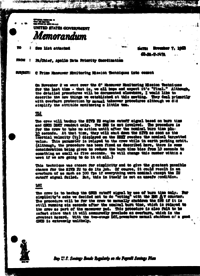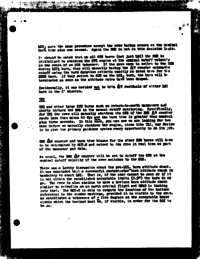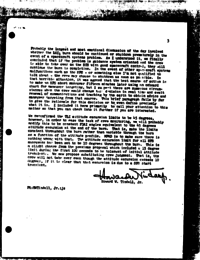See list attachedNovember 7, 196868-PA-T-247APA/Chief, Apollo Data Priority CoordinationC Prime Maneuver Monitoring Mission Techniques into cement
On November 2 we went over the C' Maneuver Monitoring Mission Techniques for the last time – that is, we all hope and expect it's “final.” Although, the detailed procedures will be documented elsewhere, I would like to describe the new things we established at this meeting. They deal primarily with overburn protection by manual takeover procedures although we did simplify the attitude monitoring a little too.
TLI
The crew will backup the SIVB IU engine cutoff signal based on burn time and GNCS DSKY readout only. The EMS is not involved. The procedure is for the crew to take no action until after the nominal burn time plus 10 seconds. At that time, they will shut down the SIVB as soon as the inertial velocity (VI) displayed on the DSKY reaches the nominal targeted value. This parameter is relayed to the crew while in earth parking orbit. (Although, the procedure has been fixed as described here, there is some consideration being given to reduce the burn time bias from 10 seconds to something as small as five seconds. We will change this number within a week if we are going to do it at all.)
This technique was chosen for simplicity and to give the greatest possible change for the SIVB IU to do its job. Of course, it could result in an overburn of as much as 500 fps if everything were nominal except the IU cutoff signal failed. But, this in itself it not an unsafe condition.
LOI
The crew is to backup the GNCS cutoff signal by use of burn time only. For simplicity's sake we decided not to do “voting” with the EMS ΔV counter. The procedure will be for the crew to manually shutdown the SPS if it is still running six seconds after the nominal burn time, which is relayed to the crew as part of the maneuver pad. This procedure is also felt to be safest since that it will assuredly preclude an overburn, which is the greatest hazard. With the two-stage LOI,premature manual shutdown of a good GNCS is extremely unlikely.
LOI₂ uses the same procedure except the crew backup occurs at the nominal burn time plus one second. Again the EMS is not in this decision logic.
It should be noted that on all SPS burns (not just LOI) the EMS is initialized to shutdown the SPS engine at the nominal cutoff velocity in the event of an SCS takeover. If the crew were to switch to the SCS during LOI₁ burn, they will manually backup the ΔV counter automatic cutoff using the burn duration criteria exactly as noted here for the GNCS burn. If they switch to SCS on the LOI₂ burn, the burn will be terminated as soon as the attitude rates have been damped.
Incidentally, it was decided not to trim ΔV residuals of either LOI burn in the C' mission.
TEI
TEI and other large SPS burns such as return-to-earth maneuvers and aborts include the EMS in the manual cutoff monitoring. Specifically, for TEI the crew will manually shutdown the SPS if the EMS ΔV counter rends less that minus 40 fps and the burn time is greater than nominal plus three seconds. In this case, you can see we are looking for two cues before we manually shutdown the engine, since like TLI, our desire is to give the primary guidance system every opportunity to do its job.
EMS ΔV counter and burn time biases for the other SPS burns will have to be determined by MCC-H and voiced to the crew in real time as part of the maneuver pad data.
As usual, the EMS ΔV counter will be set to cutoff the SPS at the nominal cutoff velocity if the crew switches to the SCS.
There was a lengthy discussion about the pre-LOI₁ burn attitude check. It was concluded that a successful sextant-star burn attitude check is mandatory to start LOI. That is, if the star cannot be seen or it it is not within the established acceptable limits (0.9°) the burn is no go. The crew is also anxious to have a horizon burn attitude check similar to retrofire on an earth orbital flight and MPAD is looking into that. The MCC-H is able to compute the location of the horizon referenced to the window markings, provided it is visible to the crew. We established a tolerance of ± five degrees as the acceptable bound within which the horizon must be, if visible, in order for the LOI to be go.
Probably the longest and most emotional discussion of the day involved whether the LOI₁ burn should be continued or shutdown prematurely in the event of a spacecraft systems problem. As I understood it, we finally concluded that if the problem is guidance system oriented and the crew is able to take over on the SCS with good spacecraft control, they will continue the burn to completion. In the event of other spacecraft systems malfunctions such as the SPS – or something else I'm not qualified to talk about – the crew may choose to shutdown as soon as possible. In that horrible situation, it was agreed that the best course of action is to make an SPS abort maneuver fifteen minutes later using an onboard chart for maneuver targeting, but I suspect there are numerous circum- stances when the crew would change this decision in real time and await renewal of communications and tracking by the earth to obtain advice and maneuver targeting from that source. This brief paragraph fails by far to give the rationale for this decision or to even define precisely what it is. I included it here primarily to call your attention to this matter so that you can check into it further if you are interested.
We reconfirmed the TLI attitude excursion limits to be 45 degrees, however, in order to ease the task of crew monitoring, we will probably modify this to be constant FDAI angles equivalent to the 45 degrees attitude excursion at the end of the burn. This is, make the limits constant throughout the burn rather than variable through the burn as a function of the attitude profile. MPAD is to make sure there is nothing wrong with that. The attitude excursion limit for all SPS maneuvers has been set to be 10 degrees throughout the burn. This is a slight change from the previous proposal which included a 15 degree limit during the first 100 seconds to be tolerant of initial attitude transients. We now propose substituting crew judgment. That is, the crew will not take over even though the attitude excursion exceeds 10 degrees, if it is clear that that excursion is due to a SPS start transient.
- Nov 12, 1968 – D Maneuver Monitoring Mission Techniques (8.0σ)
- Sep 27, 1968 – C’ Mission Techniques (4.5σ)
- Oct 16, 1968 – C’ Earth Orbit and TLI Mission Techniques Open Items (4.8σ)
- Dec 06, 1968 – C’ Abort Maneuver Overburn Monitoring (3.6σ)



